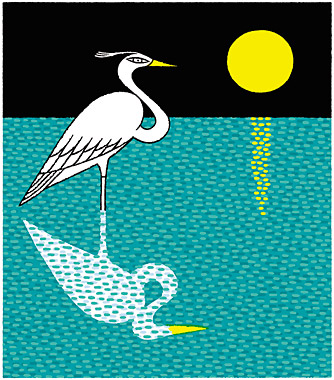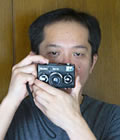 |
 |
 |
| | Home | Essay : Noh and Me | Toshiki Komazawa |
| |
|
|
There are those who were involved with Noh from a very young age.
There are those who were attracted to Noh as adults. There are all sorts of relations with Noh.
We will be speaking with a variety of people from various walks of life about their experiences
with and relation to Noh, its attraction for them and its charms.

 |
Illustration: Takeuma |
I first came to watch Noh by invitation. The place was the National Noh Theatre. Starting with the “Kōyasan Shōmyō” Buddhist chants, then the kyogen comedy “Kaki Yamabushi” and continuing to the Kanze school's “Ukai.” I didn’t get bored for a moment and was able to enjoy the performance from beginning till end. This was no doubt due to the fact that the contents were all very easy to understand and aimed at the beginning Noh performance-goer.
I already was the owner of many such shōmyō CDs, so listening to that kind of thing was easy for me. The CD I have is Nara's Todaiji's “O-mizu tori.” I also have a recording from Nara’s Yakushiji, it’s “Shōmyō Keka.“ In addition, the shōmyō from Kōyasan's Kongobuji inner temple, a recording called “Tsukinami Mieku.” I have no deep connection with Buddhism, so you may ask why I have such recordings. It is basically because I had a strong interest in the shōmyō as a reading for the sutras, or Buddhist scripts.
When you add voice to the power already inherent in the recitation of the sutras and manifest that in the form of the shōmyō chants, you have something that is, as far as I’m concerned, already music, beautiful music. Put that into the Noh theatre and listen to it live, listen to the sound of each voice, each chord, the turn of the lines, and for me I feel something very nostalgic. Just what it is that is nostalgic I’ll leave till later. Let’s move to the kyogen piece “Kaki Yamabushi,” or “The Persimmon Ascetic.”
With no explanation necessary, this comic piece tells the tale of a mountain ascetic, who upon completing his pilgrimage, descends from the mountain. His stomach empty, he steals a persimmon from someone's tree. The absurdity of an ascetic, unable to restrain himself, an ascetic who steals someone else's property, is sure to elicit laughter from the common folk. After the solemn chants of the shōmyō, the folktale is sure to even bring hearty laughter from foreign guests amongst the audience.
After the break comes “Ukai.” Two priests from the region Awa set off on a pilgrimage and find their way to Koshu. There they ask a villager for a place to spend the night. Forbidden to offer lodging to a priest on a pilgrimage, the villager suggests they stay in what is left of an old temple on the banks of the Isawa River. They are warned, however, that “a shining thing” may appear. Nevertheless, the priests decide to brave whatever it is that may appear and try to appease it with their holy powers.

At midnight the ghost appears and tells the two priests of how his sin of fishing with cormorants in an area where the taking of any life was strictly prohibited plunged him into the depths of hell. Relating the horrors of hell, the lost soul’s pain is palpable and weighs heavily upon the chests of all who listen. Here, even the novice to Noh will be able to feel the proximity of death as it was surely felt by those in the Muromachi Era, when death was all around, something you found lying nearby just about anywhere.
Probably the sight of such would have had the commoners shaking in fear at the image of hell. They would have been thinking that this is the one place they most surely do not want to go after death. The tale of the priests, saved by their incantation, would have brought home the importance of the Buddhist chants to the commoners of the day. Indeed, watching the act would have likely caused them to throw themselves upon them for redemption.
From the beginning shōmyō through to the Noh piece, one consistent source of pleasure for me, strangely, were the pauses produced by the rhythm of the flute and drums. It was these pauses in particular that had the power to act as a signal connecting this world to another. And in the spaces opened between the sound, I could feel the play of the spirit forward and back. This is what I felt to be “nostalgic,” this air that is part of Japan's nature, something that, from childhood, had no doubt permeated my entire being my way of my ears.
I have the experience of long camping trips in the national parks of America and Canada. Of course one cannot even begin to compare the scale of these with Japan. There are many places blessed with stunning mountains. Anyone would be envious of such places, visited by wild elk and bald eagles. But to be honest, while in camp at one of these places, I grew weary of it all. The deep woods and mountains of Japan, that subtle and profound something, was nowhere to be found.
In Japan, even in areas accessible by car, if it is an area somehow subtle and profound deep in the hills, along with the onset of darkness one feels a slow envelopment of a mysterious air. The quiet eeriness of the forest, the stillness of the darkness seems to connect the world to the other side of that darkness. Toward midnight, from somewhere deep in the forest, one can hear the frightening cry of the chimera.

It's at these times, when life and death are so close, that I have the feeling that they are one. It's a feeling that comes without thinking, one that rises naturally in my heart. Or one could say it is some power that gives rise to that thought, a power that is at the heart of Japan's nature. Borrowing the power of this emotion, spending a night in the forest, it somehow connects me to myself and to the times since childhood when I would feel a kind of “transience.”
I feel that Noh, in a highly abstract way, is able to elicit, from the deepest levels, the nature of Japan and the hearts of the Japanese people. And, in the midst of a performance, I have closed my eyes a number of times, and listened intensely to the sound, the rhythm and the pauses in between. From somewhere within those depths come, clearly and quickly, “images.” This is what I feel Noh is truly about, not the images of what one actually sees before oneself, but the images that arise from within.
(MAY 2008)
 |
Toshiki Komazawa Komazawa was born in Tokyo in 1961. Writer and translator with the editorial department of Switch magazine. Author of the novel “Yoru wa mo Aketeiru” and the travelogue “Kataru ni Taru, Sasayaka na Jinsei.” Translator of a number of works, including “Makū no Mori (Hexwood 1993)” by Diana Wynne Jones. The epic novel “Voyager ni Tsutaete” is in the works and expected to be published in the near future. |
| Terms of Use | Contact Us | Link to us |
Copyright©
2026
the-NOH.com All right reserved.